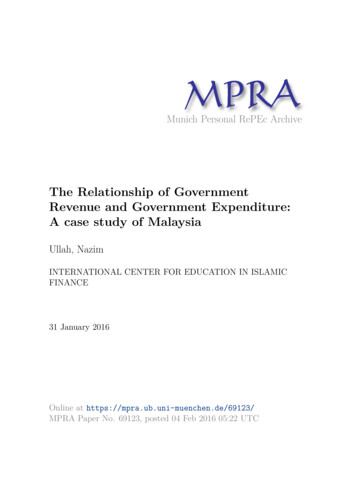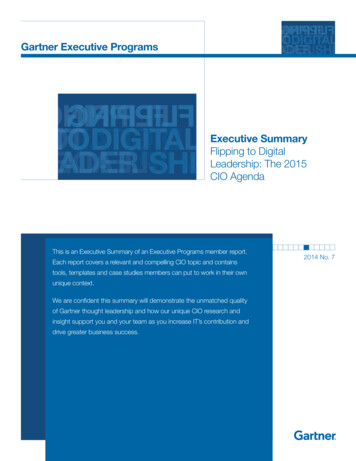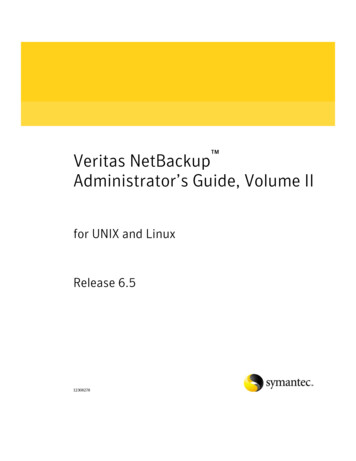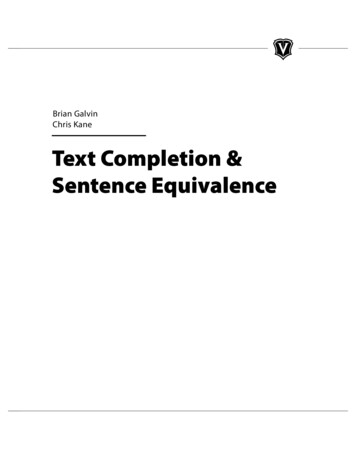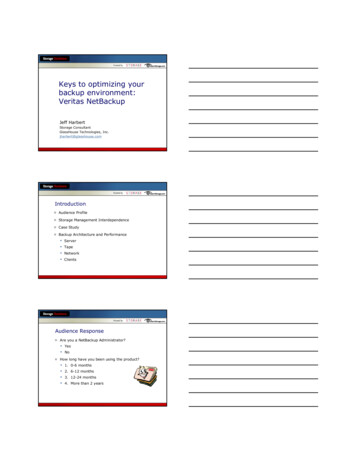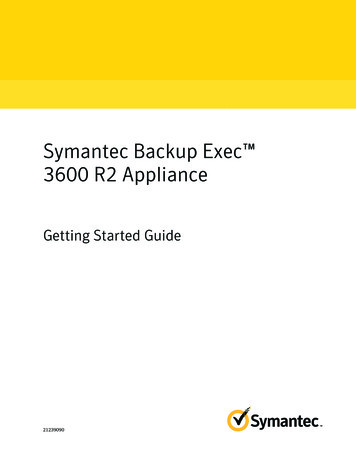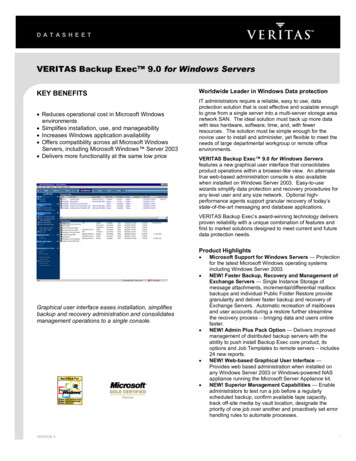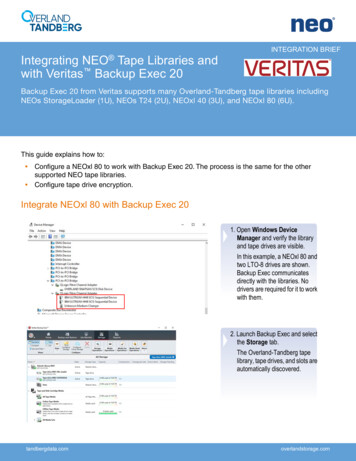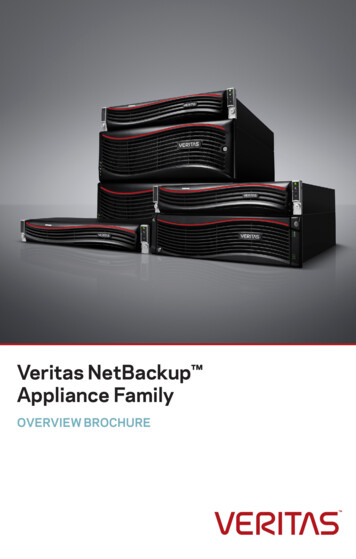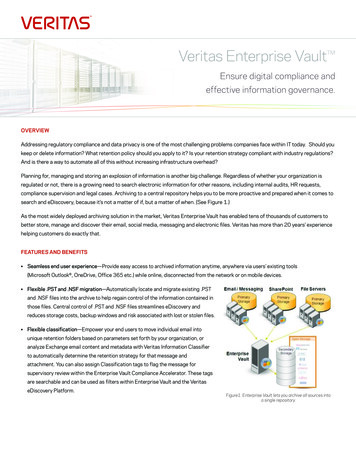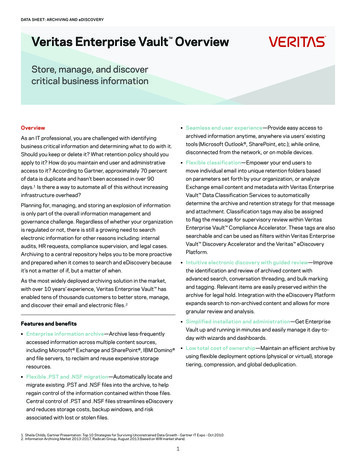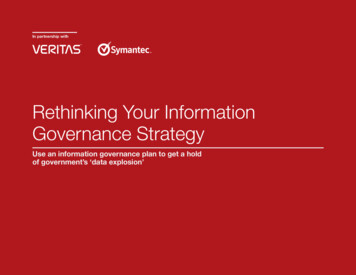
Transcription
In partnership withRethinking Your InformationGovernance StrategyUse an information governance plan to get a holdof government’s ‘data explosion’Page 1
Rethinking your informationgovernance strategyUse an information governance plan to get a hold of government’s ‘data explosion’Government’s digital paper trail is growing bythe day, and digital records, such as email,make up the bulk of an agency’s archive. “Thesestored records are causing a ‘data explosion’ inrecordkeeping,” says Stephen Watts, FederalArchitect for Archiving and eDiscovery at VeritasTechnologies Corporation. “And, it’s causingmany federal leaders to rethink their informationgovernance strategy, a plan that can definerecords management policies and procedures.”“The long-time adage of storage is cheap, solet’s add to it, is no longer the case,” he says.“We recently found that one petabyte [1,000,000gigabytes] of data costs an organization about 5 million a year to manage. People used tothink that storage was the solution, but reallyit’s about defining your archive retention andinformation governance strategy.”Over the course of the next week, you’ll hearfrom Stephen Watts and his colleague, PhilYaccino, Public Sector Architect for InformationGovernance at Veritas, on effective strategiesfor an information governance strategy. Thiscourse will guide you through processes, likeemail modernization, records archiving andretention and eDiscovery.In order to meet compliance and create arobust archive that can be quickly and efficientlysearched, leaders should ask three, key questions:69%According to a recent report from the NationalArchives and Records Administration, half of1. What kind of data do I need to look for?federal agencies are at a moderate or high riskFederal leaders need to know where the dataof mismanaging records. Meanwhile, federalwas stored, when it was stored, who stored it,leaders are working towards a looming deadline:and what metadata was associated with it.December 31, 2016. That’s when agenciesmust comply with President Barack Obama’s2. Can I take action on my data?Managing Government Records DirectiveOnce you have the information, the data(M-12-18), a mandate that makes both permahas to help agencies take action on thingsnent and temporary email records accessible insuch as retention schedules and defensiblean electronic format.deletion policies.The countdown to compliance can feel nerve3. Can I search my data quickly and efficiently?wracking, Watts says, but agencies need to reAgencies must be able to produce recordsthink their strategy because adding more storagefor audits, investigations and public recordssimply is not a sufficient methodology anymore.requests. Federal leaders need to identify theright records in a timely and efficient manner.Page 2Of information holds no business, legal,or regulatory value at all.“Really, your information governance strategydrives discoverability. It helps you discoverinformation, so that you can really learn from andmanage records efficiently,” Watts says. “Youhave to constantly be thinking about it becauseinformation governance is constantly evolving.”
Enabling email modernization andautomationFinding the email in the haystack“When government first started using email fordaily correspondence, most assumed it was acommunications tool, but federal leaders nowconsider email to be a digital record,” saysStephen Watts, Federal Architect for Archivingand eDiscovery at Veritas.Email volumes continue to grow, which makessearching for and identifying an email recordsimilar to finding a needle in a haystack. Mostgovernment agencies are now on a path toemail modernization, either for compliance purposes or to efficiently manage digital records.One key piece to email modernization is automation, Watts says, a process that classifiesand manages the vast amount of email recordsautomatically. Many federal agencies are working toward Capstone Compliance in an effort toachieve email modernization. According to theCapstone directive, agencies should be able to: Ensure all email records are scheduled Prevent unauthorized access, modification, ordeletion of records Make sure all records in the repository areretrievable and usablePage 3 Consider whether emails and attachmentscan be associated with related records Capture and maintain required metadataassociated with each recordBut agencies can’t keep everything. Watts offersthe following advice on how to determine which records to preserve and move toward modernization.Scope of Email RecordsFirst, federal leaders will want to determine thescope of email that is subject to recordkeeping.Consider if managing email at the account levelis suitable for your agency. Do you need toretain all employee email? With certain tools,agencies can establish permanent and temporary email accounts, creating classifications forindividuals within an organization.“If it’s someone in a general counsel’s office,they would be defined as permanent, whilea facilities maintenance worker might have atemporary email account. By doing this, youcan vary the rules and limit the amount of emailrecords that you need to be focused on,” Wattssays. The goal is to determine what should bekept versus the unimportant employee chatter.Imagine if you onlyhad to send 5 GB ofdata to your law firmto review instead of500 GB and legal –not IT – did much ofthe work.
The Risk of Keeping EverythingThere’s an underlying risk and cost associatedwith keeping everything for forever, Watts says.After deciding upon the scope of records to bepreserved, agencies can employ email automation features to save both time and money whilemaintaining the data archive for retrieval.‘Journaling’ for Permanent RecordkeepingFor records that need to be kept forever, emailautomation can enable “journaling.” Think ofjournaling as the official, true record, Wattssays. With journaling, the email system capturesan immutable copy of the communication,independent of any end-user interaction.Metadata, or basic summary information abouta record, is key to automating the archivingprocess without any end-user interaction. Thiscan be especially useful for actions like defensible deletion, Watts says — a process thatdetermines when an email can be stricken fromthe archive.To begin the process of email modernizationand implement strategies for efficient recordsmanagement, download this whitepaper detail-“Defensible deletion allows agencies to deleterecords based off certain policies or prescriptions. For instance, an agency might only keeprecords for a specific period of time, and thenthey will purge those records,” Watts says.Page 4ing the steps agencies should take to achievedigital records compliance.
Three steps to an eDiscoverystrategyKnowing the who, what, where, when, and why’s of a recordLawsuits, corporate investigations, Congressionalsubpoenas, and regulatory audits are increasing.And, according to the Justice Department’s Officeof Information Policy, the Freedom of InformationAct backlog grew by 67 percent last year — closeto 160,000 individual public records requests.accidentally destroyed, lost or expunged due tomeeting retention.Step 2: Processing, Analysis, and Review ofArchive RecordsThe next step is to process the request, analyzethe relevant records, and review each recordfor any privileged or sensitive information. TheIn order for electronically stored information toprocessing step refers to the crawling, indexing,be accessible and ready for a records request,agencies should keep in mind a set of eDiscovery and culling of records, including any conversionthat enables analysis and review to be doneprocedures to use.electronically. In the analysis phase, records arereviewed for relevant summary information, such“When you can answer all the questions that aas key topics, people, and timelines critical to thereporter would ask — who, what, where, when,and why — then you have a solid information gov- request. Finally, in the review phase, the recordsare given a detailed look for relevance andernance strategy,” says Stephen Watts, Federalprivileged information.Architect for Archiving and eDiscovery at Veritas.Step 1: Identification and Preservation forArchive CollectionThe first step is to identify your records. Agenciesneed to detect all of their records that needto be preserved and potentially collected. Thegoal should be for agencies to first identifythe custodian of the record, the appropriatedate ranges for the record, and the sources ofrecords involved. During preservation, the goalis to institute a “hold,” ensuring that potentiallyrelevant and responsive records are notPage 5Step 3: Production and Presentation ofArchive RecordsThe final phase of the eDiscovery process focuses on preparing and producing the digital recordsfor courts, regulators, or public audiences.Production refers to the process of turning overrecords in the format requested. It’s importantto verify that production details, such as form,media, and schedule are negotiated and agreedupon by both parties. Then, an agency enters thepresentation phase, which refers to the processof turning over electronic data at depositions,hearings, and trials to elicit further information. 18,000The average cost to take just 1GB of datathrough the eDiscovery processeDiscovery is a fact of life for governmentleaders, and yet many agencies still struggle withthis critical task. Download this report to seewhich enterprise information archiving productworks best for your needs.It’s important to be proactive and to follow aprescribed framework, Watts says. “It’s not aquestion of if, but when.”
Making decisions with yourdata archiveAn information governance strategy requires data insightArchiving is the first step towards an effectiveinformation governance strategy, but to reallytake hold and gain value from your data,agencies need to be able to draw insight fromthose records.“An information governance strategy is muchmore than just keeping data around,” says PhilYaccino, Public Sector Architect for InformationGovernance at Veritas. “You have to know whatyour data looks like, what content information itcontains, and the types of records that you have.”Using Data to Take ActionThis data knowledge is what helps an agencywhen it faces something like a public recordsrequest or audit. It’s also the way agencies canevaluate their records, identifying gaps wherefurther efficiencies can be achieved.For example, by looking at email records,an agency might be able to reduce storageneeds by retaining only essential emails andeliminating transient messages that often makeup the bulk of inbox traffic.Knowing your data can also help save timewhen it comes to archive discovery, which canbe particularly useful in cutting down wait timesPage 6for things like FOIA requests, Yaccino says. Withgreater insight, agencies can begin to define theirretention policies and schedules, allowing themto take action on things like defensible deletionor the movement of data across servers. 1.5%More data does not mean more value.Target-rich data 1.5% of all dataDeveloping a Records Retention PlanData insight hinges on an effective retentionplan, or set of rules that are used to govern howlong records are kept.“There is a big risk associated with keepingall your data and not doing anything with it,”Yaccino says. “You could put your agency atrisk if there’s an internal review or public recordsrequest. You’re saving yourself both time andmoney if you know your content and store itcorrectly with retention definitions.”Most agencies struggle with records retentionbecause it requires a coordinated discussionbetween IT, records management, and legalservices. These groups need to come togetherand decide on things like the record’s format,metadata, retention, and value, Yaccino says.“You have to be thinking about your agency’sbasic and advanced archiving needs, and howthey will help lead to greater insight.”Often times a storage problem is not a storageproblem at all, but rather a management issue.Download this research note and learn how to getstarted on an information governance strategy.Only after this conversation can governmentleaders look for tools that do the work ofsearching the network and creating value. “Youwant to implement archiving tools that can assignand automatically set retention rates,” Yaccinosays. “And you want to automate the process forhow long a record is kept and why it’s kept.”
Using the right tools to advance yourinformation governance strategyWithout a dedicated information governancestrategy in place, federal leaders canspend valuable time and money managingunnecessarily large amounts of data.“One agency in particular right now has 8 petabytes [8,000,000 gigabytes] of storage, and theirmanagement cost is approaching 40 million peryear,” says Phil Yaccino, Public Sector Architectfor Information Governance at Veritas.Cost is a main driver and so is efficiency. Often,it’s the time that it takes an agency to process arecord that can cause them to rethink their information governance strategy, Yaccino says. “Ifyou can’t turn around a public records requestin time, you might be putting your agency at areputational or legal risk,” he says.To maximize on both cost and efficiency,Yaccino says there are three tools that agenciesshould consider when it comes to advancingtheir information governance strategy.Tool #1: Digital Archive ManagerArchiving tools, such as Enterprise Vault orEnterprise Vault.cloud, give government leadersthe ability to efficiently store and discover unstructured data from their digital email records.Page 7“Some agencies have rules and regulations ontheir data collection and storage. And everyagency has their own unique requirement forwhether they need an on-premise or cloudsolution,” Yaccino says. “Whether it’s cloud oron-premise, it’s about finding the right fit.”1 yearNeuralytix shows that in almost everycase, Information Governance initiativescan completely pay for themselves in thefirst year of deployment.Tool #2: Data InsightDrawing data insight from archived recordscan help agencies improve their informationgovernance strategies by providing actionableintelligence to data ownership, usage, andaccess controls.There are a number of advanced analyticstools that can help government leaders gainknowledge into their data. One of them, DataInsight, helps agencies identify each data ownerand gives greater visibility into the data, providing historical context into the record, so thatactionable steps, such as defensible deletion orretention, can take place.Tool #3: eDiscovery PlatformAn eDiscovery platform can help governmentsee through the electronic discovery process— from collection to production of recordsrequests or audits. An enterprise solution, suchas the one powered by Veritas, can bring aboutgreater transparency and control of the electronic discovery process.Particularly for government, which deals withhundreds of thousands of public records requestseach year, there’s a real need to deliver information in a timely manner. An effective platform willrapidly cull-down data and automate the recordsreview throughout the eDiscovery process.“In general, there’s a real sense of urgencyfor government leaders who can’t put off theirinformation governance strategy any longer,”Yaccino says. “There’s a deadline and thatmeans government leaders have to adhere tospecific requirements and records requests forthe public good.”
Page 8
Finding the email in the haystack “When government first started using email for daily correspondence, most assumed it was a communications tool, but federal leaders now consider email to be a digital record,” says Stephen Watts, Federal Architect for Archiving and eDiscovery at Veritas.
